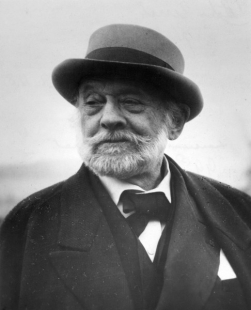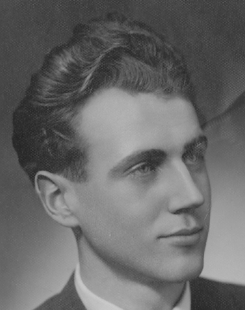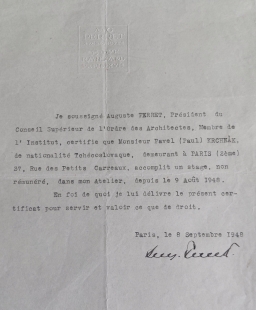
Meeting of Pavel Krchňák with architectural giant Auguste Perret
In 1947, about 10 university students were selected for an internship in France with the renowned world architect Auguste Perret*, who at that time was working on the generous reconstruction of Le Havre** that had been destroyed by bombing at the end of World War II. One of the selected was also Pavel Krchňák, a third-year student of the Faculty of Architecture at the Technical University in Brno. The students worked intensively in Perret's office in Paris for a whole month from morning till evening and looked forward to traveling around France after the internship with the money they earned. The internship came to an end, but they did not receive any money with the explanation that the internship with the world-famous architect Perret was an honor, and that they should be grateful for the experience gained. To have something to travel with, they needed at least some money, so they came up with a plan. They approached Perret, saying that no one back home in Czechoslovakia would believe that they had actually worked for a whole month for free, and that they would be grateful if he could confirm it in writing. The experienced architect not only issued this document, but he also ended up giving the interns pocket money, with which they eventually fulfilled their wishes and traveled around France.
* The Auguste Perret Prize is an award given by the International Union of Architects (UIA) named after the French architect and builder Auguste Perret (1874–1954). It honors architects who have achieved international recognition or who use modern technologies in their work. The prize was first awarded in 1961 and since then, architects have been recognized every three years (every two years until 1969).
** The port city of Le Havre was heavily damaged by bombs during World War II. From 1945 to 1964, it was rebuilt by a team of architects and builders led by Auguste Perret. The site includes the administrative, commercial, and cultural center of the city. Le Havre is exceptional among other reconstructed cities for its integrity and coherence. It combines old historic buildings with new urban ideas and new construction technologies. It is a unique example of post-war urban planning and architecture, including the use of prefabricated elements and new applications of concrete structures.
* The Auguste Perret Prize is an award given by the International Union of Architects (UIA) named after the French architect and builder Auguste Perret (1874–1954). It honors architects who have achieved international recognition or who use modern technologies in their work. The prize was first awarded in 1961 and since then, architects have been recognized every three years (every two years until 1969).
** The port city of Le Havre was heavily damaged by bombs during World War II. From 1945 to 1964, it was rebuilt by a team of architects and builders led by Auguste Perret. The site includes the administrative, commercial, and cultural center of the city. Le Havre is exceptional among other reconstructed cities for its integrity and coherence. It combines old historic buildings with new urban ideas and new construction technologies. It is a unique example of post-war urban planning and architecture, including the use of prefabricated elements and new applications of concrete structures.
The English translation is powered by AI tool. Switch to Czech to view the original text source.



0 comments
add comment












